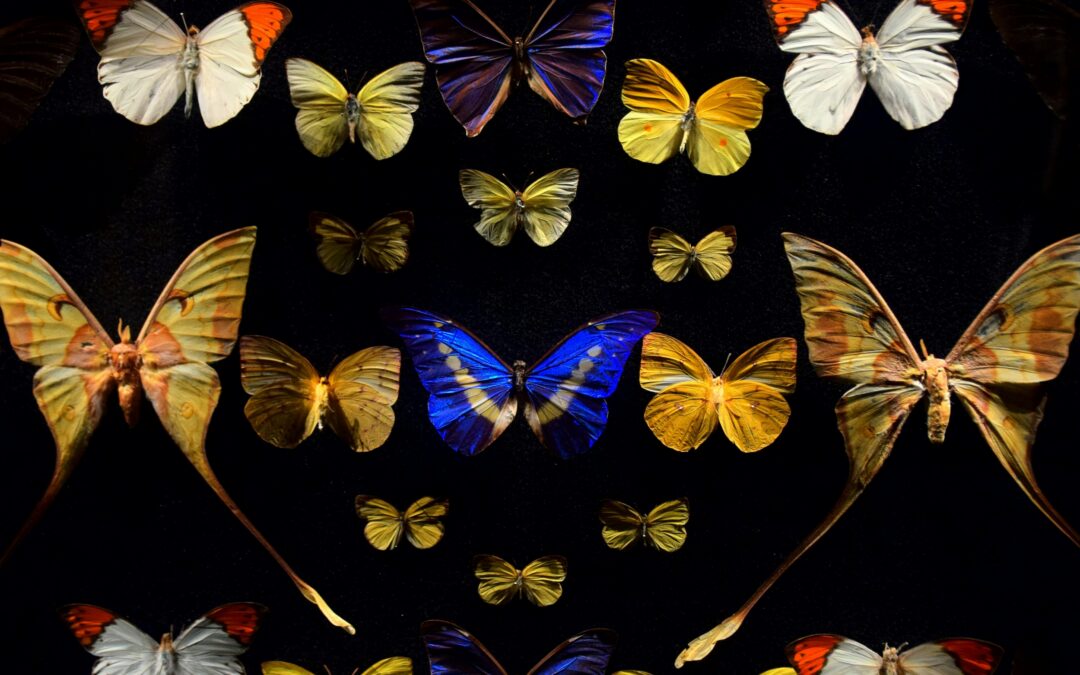
by Robyn Bolton | Feb 18, 2025 | Innovation, Leadership, Metrics, Tips, Tricks, & Tools
Innovation is undergoing a metamorphosis, and while it may seem like the current goo-stage is the hard part (it’s certainly not easy!), our greatest challenge is still ahead. Because while we may emerge as beautiful butterflies, we still need to get buy-in for change from a colony of skeptical caterpillars who’ve grown weary of transformation talk.
The Old Playbook Is Dead, Too
Picture this: A butterfly lands, armed with PowerPoint slides about “The Future of Leaf-Eating” and projections showing “10x Nectar Collection Potential.” The caterpillars stare blankly, having seen this show before.
The old approach – big presentations, executive sponsorship, and promises of massive returns within 24 months – isn’t just ineffective. It’s harmful. Each failed transformation makes the next one harder, turning your caterpillars more cynical and more determined to cling to their leaves.
The Secret Most Change Experts Miss
Butterflies don’t convince caterpillars to transform by showing off their wings. They create conditions where transformation feels possible, necessary, and safe. Your job isn’t to sell the end state – it’s to help others see their own potential for change.
Here’s how:
Start With the Hungriest Caterpillars
Find those who feel the limitations of their current state most acutely. They’re not satisfied with their current leaf, and they’re curious about what lies beyond. These early adopters become your first chrysalis cohort.
Make it About Their Problems, Not Your Vision
Instead of talking about transformation, focus on specific pain points. “Wouldn’t it be easier to reach that juicy leaf if you could fly?” is more compelling than “Flying represents a paradigm shift in leaf acquisition strategy.”
Build a Network of Proof
Every successful mini-transformation creates evidence that change is possible. When one caterpillar successfully navigates their chrysalis phase, others pay attention. Let your transformed allies tell their stories.
Set Realistic Expectations
Metamorphosis takes time and isn’t always pretty. Be honest about the goo phase – that messy middle where things fall apart before they come together. This builds trust and prepares people for the real journey, not the sanitized version.
Where to Start
- Identify your first chrysalis cohort – the people already feeling the limits of their current state
- Focus on solving immediate problems that showcase the benefits of change
- Document and share small victories, letting others tell their transformation stories
- Create realistic timelines that acknowledge both quick wins and longer-term metamorphosis
What’s your experience? Have you successfully guided a transformation without relying on buzzwords and fancy presentations? Drop your stories in the comments.
After all, we’re all just caterpillars and butterflies helping each other find our wings.

by Robyn Bolton | Feb 12, 2025 | Innovation, Leadership
When times get tough, the first things most companies cut are the “luxuries.” That includes their innovation teams. But as companies dismantle their labs, teams, and other structures, a crucial question emerges: Who’s working on growth?
Cutting innovation teams doesn’t just cut a branch off the org chart. It eliminates capabilities that are fundamental to sustaining and growing a business and culture.
So why throw the baby out with the bathwater? Here’s a scenario that might sound familiar: Your innovation team created something brilliant. The prototype works, early users love it, and the business case is solid. But six months later, it’s gathering dust because no one in the core business knew how to—or wanted to—move it forward.
This isn’t a failure of innovation. It’s a failure of integration.
Wait, I thought integrating innovation with the core business was bad
The traditional innovation team structure – a separate unit with its own space, processes, and culture – solved one problem but created another.
As innovation teams were given the freedom to think differently, they were also given shiny, new, fun, and amenity-filled spaces cordoned off from everyone else. Meanwhile, “everyone else” was stuck in their usual offices and doing the usual things that keep the business running and fund the innovation team’s luxe life.
The resulting us-versus-them mentality fueled resentment, making it easy for “everyone else” to stonewall the innovation team’s efforts by pointing out flaws, uncertainties, and risks.
To be fair, they weren’t doing this to be mean – they were protecting the business. The innovators, meanwhile, grew frustrated, sought help from higher-ups who were happy to help until times got tough and cuts had to be made.
So, one team should work on both innovation and the core business?
Just like we need multiple words to describe the what and why of innovation, we need different operating models that embed innovation capabilities across the organization while protecting the space for them to flourish.
Here’s what it looks like:
- For Core Improvements, let your operational teams lead. They know the problems best, but give them innovation tools and methods. Think of this as equipping your existing workforce with new superpowers, not replacing them with superheroes.
- For Adjacent Expansions, create hybrid teams that combine operational experience with innovation expertise. When expanding into new markets or launching new products, you need both an innovative mindset and operational know-how. Neither alone is sufficient.
- For Radical Reinvention, you still need dedicated teams—but not isolated ones. Their job is to create offerings that reinvent the company and the culture that enables everyone to participate. Establish bridges that connect them with business units and enforce quarterly meetings to share progress, insights, and tools.
This isn’t theory.
Companies like Amazon have been doing this for years with their “working backwards” innovation process used by all teams, not just a special innovation unit. When I worked at P&G, the brand teams worked on core improvements, the New Business Development teams (where I worked) physically sat next to the brand teams and worked on Adjacent expansion, and the radical reinvention teams were co-located with R&D at the technical centers.
Put it into practice
Here’s where to start:
- Map your innovation portfolio to understand what types of innovation you need to hit your goals
- Match your team structures to your innovation types
- Start embedding innovation capabilities across the organization
- Create clear paths for innovations to move from idea to implementation
The transition isn’t easy. It requires rethinking roles and reimagining how innovation happens in your organization. But the alternative – watching your innovation investments evaporate because they can’t cross the bridge back to the core business – is far more painful.
What’s your experience? Drop your stories and strategies in the comments. Let’s figure this out together.

by Robyn Bolton | Feb 3, 2025 | Innovation, Tips, Tricks, & Tools
If innovation (the term) is dead and we will continue to engage in innovation (the activity), how do we talk about creating meaningful change without falling back on meaningless buzzwords? The answer isn’t finding a single replacement word – it’s building a new innovation language that actually describes what we’re trying to achieve. Think of it as upgrading from a crayon to a full set of oil paints – suddenly you can create much more nuanced pictures of progress.
The Problem with One-Size-Fits-All
We’ve spent decades trying to cram every type of progress, change, and improvement into the word “innovation.” It’s like trying to describe all forms of movement with just the word “moving.” Sure, you’re moving but without the specificity of words like walking, running, jumping, bounding, and dancing, you don’t know what or how you’re moving or why.
That’s why using “innovation” to describe everything different from today doesn’t work.
Use More Precise Language for What and How
Before we throw everything out, let’s keep what actually works: Innovation means “something new that creates value.” That last bit is crucial – it’s what separates meaningful change from just doing new stuff for novelty’s sake. (Looking at you, QR code on toothpaste tutorials.)
But, just like “dancing” is a specific form of movement, we need more precise language to describe what the new value-creating thing is that we’re doing:
- Core IMPROVEMENTS: Making existing things better. It’s the unglamorous but essential work of continuous refinement. Think better batteries, faster processors, smoother processes.
- Adjacent EXPANSIONS: Venturing into new territory – new customers, new offerings, new revenue models, OR new processes. It’s like a restaurant adding delivery service: same food, new way of reaching customers.
- Radical REINVENTION: Going all in, changing multiple dimensions at once. Think Netflix killing its own DVD business to stream content they now produce themselves. (And yes, that sound you hear is Blockbuster crying in the corner.)
Adopt More Sophisticated Words to Describe Why
Innovation collapsed because innovation became an end in and of itself. Companies invested in it to get good PR, check a shareholder box, or entertain employees with events.
We forgot that innovation is a means to an end and, as a result, got lazy about specifying what the expected end is. We need to get back to setting these expectations with words that are both clear and inspiring
- Growth means ongoing evolution
- Transformation means fundamental system change (not just putting QR codes on things)
- Invention means creating something new without regard to its immediate usefulness
- Problem Solving means finding, creating, and implementing practical solutions
- Value Creation means demonstrating measurable and meaningful impact
Why This Matters
This isn’t just semantic nitpicking. Using more precise language sets better expectations, helps people choose the most appropriate tools, and enables you to measure success accurately. It’s the difference between saying “I want to move more during the day” and “I want to build enough endurance to run a 5K by June.”
What’s Next?
As we emerge from innovation’s chrysalis, maybe what we’re becoming isn’t simpler – it’s more sophisticated. And maybe that’s exactly what we need to move forward.
Drop a comment: What words do you use to describe different types of change and innovation in your organization? How do you differentiate between what you’re doing and why you’re doing it?

by Robyn Bolton | Jan 29, 2025 | Innovation
Innovation has always had its problems. It’s a meaningless buzzword that leads to confusion and false hope. It’s an event or a hobby that allows executives to check the “Be innovative” box on shareholders’ To-do lists. It’s a massive investment that, if you’re lucky, is break-even.
So, it should be no surprise that interest and investment have dried up to the point that many have declared that innovation is dead.
If you feel an existential crisis coming on, you’re not alone. Heck, I’m about to publish a book titled Unlocking Innovation, which, if innovation is dead, is like publishing “Lean Speed: How to Make Your Horse Eat Less and Go Faster” in 1917 (the year automobiles became more prevalent than horses).
But is innovation really dead?
Yes, innovation is dead.
The word “innovation” is dead, and it’s about time. Despite valiant efforts by academics, consultants, and practitioners to define innovation as something more than a new product, decades of hype have irrevocably reduced it to shiny new objects, fun field trips and events, and wasted time and money.
Good riddance, too. “Innovation” has been used to justify too many half-hearted efforts, avoidable mistakes, and colossal failures to survive.
Except that it is also very much not dead.
While the term “innovation” may have flatlined, the act of innovating – creating something new that creates value – is thriving. AI continues to evolve and find new roles in our daily lives. Labs are growing everything from meat to fabric to new organs. And speaking of organs, three patients in the US received artificial hearts that kept them alive long enough for donor hearts to be found.
The act of innovation isn’t dead because the need for innovation will always exist, and the desire to innovate – to create, evolve, and improve – is fundamentally human.
Innovation is metamorphosing (yes, that’s a real word)
Like the Very Hungry Caterpillar, innovation has been inching along, gobbling up money and people, getting bigger, and taking up more space in offices, budgets, and shareholder calls.
Then, as the shock of the pandemic faded, innovation went into a chrysalis and turned to goo.
Just as a caterpillar must break down completely before becoming something new, we’re watching the old systems dissolve:
- Old terms like innovation and Design Thinking were more likely to elicit a No than a Yes
- Old structures like dedicated internal teams and “labs” were shut down
- Old beliefs that innovation is an end rather than a means to an end faded
This is all good news. Except for one tiny thing…
We don’t know what’s next
Humans hate uncertainty, so we’re responding to the goo-phase in different ways:
- Collapse in defeat, lament the end of human creativity and innovation, and ignore the fact that cutting all investment in creativity and innovation is hastening the end you find so devastating
- Take a deep breath, put our heads down, and keep going because this, too, shall pass.
- Put on our big kid pants, muster some courage, ask questions, and start experimenting
I’ve been in #2 for a while (with brief and frequent visits to #1), but it’s time to move into #3.
I’ll start where I start everything – a question about a word – because, before we can move forward, we need a way to communicate.
If innovation (the term) is dead, what do we use instead?
We’ll explore answers in the next post, so drop your words and definitions in the comments.

by Robyn Bolton | Jan 22, 2025 | Innovation, Leadership, Metrics, Stories & Examples
“Consider this question: If workers are hobbled by 1,000 rules, does it make a meaningful difference to reduce them to only 900?”
The answer is No. In fact, this is precisely why most attempts at fighting bureaucracy fail – and why true transformation requires starting completely fresh.
Bill Anderson, CEO of Bayer, knows this and isn’t afraid to admit it. When he took the helm in June 2023, he discovered a company paralyzed by bureaucracy. Instead of trying to optimize the system, he looked at the company’s “1,362 pages” of employee rules and knew the entire structure needed to change.
Breaking the Stranglehold
As Anderson stated in Fortune, “There was a time for hierarchical, command-and-control organizations – the 19th century, to be exact, when many workers were illiterate, information traveled at a snail’s pace, and strict adherence to rules offered the competitive advantage of reliability.”
The modern reality is different. Today’s Bayer employs highly skilled experts, operates at digital speed, and competes in markets where, as Anderson observes, “the most reliable companies are the most dynamic.”
The challenge wasn’t just the encyclopedic rulebook. The organization’s “12 levels of hierarchy” created what Anderson called “unnecessary distance between our teams, our customers, and our products.” In today’s innovation-driven market, this industrial-age structure threatened the company’s future.
Unleashing Innovation
Anderson’s solution? “Dynamic Shared Ownership” – a radical model that puts 95% of decision-making in the hands of the people actually doing the work. Instead of annual budgets and endless approvals, self-directed teams work in 90-day sprints with the autonomy to make real-time decisions.
The results are already showing. Take Vividion, Bayer’s independently operated subsidiary. Operating in small, autonomous teams, they went from FDA approval to first patient dosing in just six weeks. They’re now on track to produce one or two new drug candidates for clinical testing every year.
Speed Becomes Reality
The impact extends across the organization. Bayer’s scientists have transformed their plant breeding process, reducing cycles from “five years down to merely four months.”
In the consumer health division, teams have accelerated their development timelines significantly, reducing product launch schedules “by up to nine months” in Asia. Within their first two months under the new system, these teams generated millions in additional value.
While financial markets remain uncertain about this transformation, one crucial metric suggests it’s working: employee retention has improved. The scientists, researchers, and product developers – the people doing the innovative work – are showing their confidence in this dramatic shift toward autonomous operation.
Why This Matters & What to do Next
For most of us, the question isn’t whether our organization has too much bureaucracy – it almost certainly does. The question is: what are you going to do about it?
Try this – Create a small, autonomous team with a 90-day mission. Give them real decision-making power and see what they can accomplish when freed from bureaucratic constraints.
Remember Anderson’s key insight: reducing rules from 1,000 to 900 won’t create meaningful change. Real transformation requires the courage to fundamentally rethink how work gets done.
For anyone who’s ever felt the soul-crushing weight of bureaucracy, Bayer’s radical reinvention offers hope. Maybe the path to innovation isn’t through better rules and processes, but through the courage to trust in human potential.

by Robyn Bolton | Jan 15, 2025 | Innovation, Leadership, Stories & Examples
I firmly believe that there are certain things in life that you automatically say Yes to. You do not ask questions or pause to consider context. You simply say Yes:
- Painkillers after a medical procedure
- Warm blankets
- The opportunity to listen to brilliant people talk about things that fascinate them.
So, when asked if I would like to attend an Executive Briefing curated by MIT’s Industrial Liaison Program, I did not ask questions or pause to check my calendar. I simply said Yes.
I’m extremely happy that I did because what I heard blew my mind.
Lean is the enemy of learning
When Ben Armstrong, Executive Director of MIT’s Industrial Performance Center and Co-Lead of the Work of the Future Initiative, said, “To produce something new, you need to create a lot of waste,” I nearly lept out of my chair, raised my arms, and shouted “Amen brother!”
He went on to tell the story of a meeting between Elon Musk and Toyota executives shortly after Musk became CEO. Toyota executives marveled at how quickly Tesla could build an EV and asked Musk for his secret. Musk gestured around the factory floor at all the abandoned hunks of metal and partially built cars and explained that, unlike Toyota, which prided itself on being lean and minimizing waste, Tesla engineers focused on learning – and waste is a required part of the process.
We decide with our hearts and justify with our heads – even when leasing office space
John E. Fernández, Director of MIT’s Environmental Solutions Initiative, shared an unexpected insight about selling sustainable buildings effectively. Instead of hard numbers around water and energy cost savings, what convinces companies to pay the premium for Net Zero environments is prestige. The bragging rights of being a tenant in Winthrop Center, Boston’s first-ever Passive House office building, gave developers a meaningful point of differentiation and justified higher-than-market-rate rents to future tenants like McKinsey and M&T Bank.
49% of companies are Silos and Spaghetti
I did a hard eye roll when I saw Digital Transformation on the agenda. But Stephanie Woerner, Principal Research Scientists and Executive Director for MIT’s Center for Information Systems Research, proved me wrong by explaining that Digital Transformation requires operational excellence and customer-focused innovation.
Her research reveals that while 26% of companies have evolved to manage both innovation and operations, operate with agility, and deliver great customer experiences, nearly half of companies are stuck operating in silos and throwing spaghetti against the wall. These “silo and spaghetti companies” are often product companies rife with complex systems and processes that require and reward individual heroics to make progress.
What seems like the safest option is the riskiest
How did 26% of companies transform while the rest stayed stuck or made little progress? The path forward isn’t what you’d expect. Companies that go all-in on operational excellence or customer innovation struggle to shift focus and work in the other half of the equation. But doing a little bit of each is even more risky because the companies often wait for results from one step before taking the next. The result is a never-ending transformation slog that is eventually abandoned.
Academia is full of random factoids
They’re not random to the academics, but for us civilians, they’re mainly helpful for trivia night:
- 50% of US robots are used in the automotive industry
- <20% of manufacturing job descriptions require digital skills (yes, that includes MS Office)
- Data centers will account for 8-21% of global energy demand by 2030
- Energy is 10% of the cost of running a data center but 90% of the cost of mining bitcoin
- Cities take up 3% of the earth’s surface, contain 33% of the population, account for 70% of global electricity consumption, and are responsible for 75% of CO2 emissions
Why say Yes
When brilliant people talk about things they find fascinating, it’s often because those things challenge conventional wisdom. The tension between lean efficiency and innovative learning, the role of emotion in business decisions, and the risks of playing it too safe all point to a fascinating truth: sometimes the most counterintuitive path forward is the most successful.
How have you seen this play out in your work?





